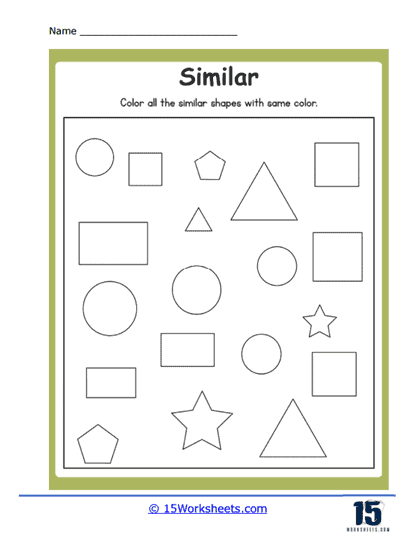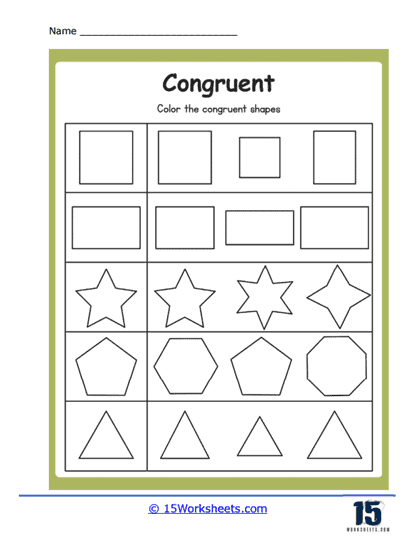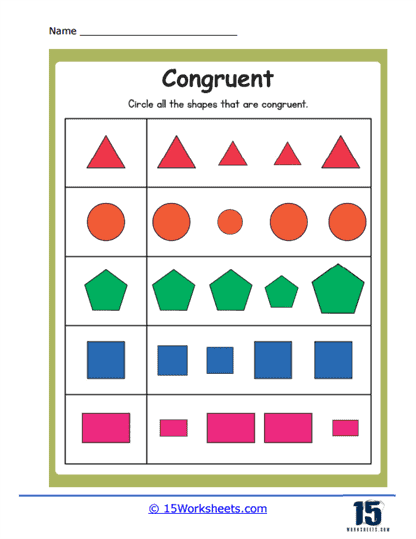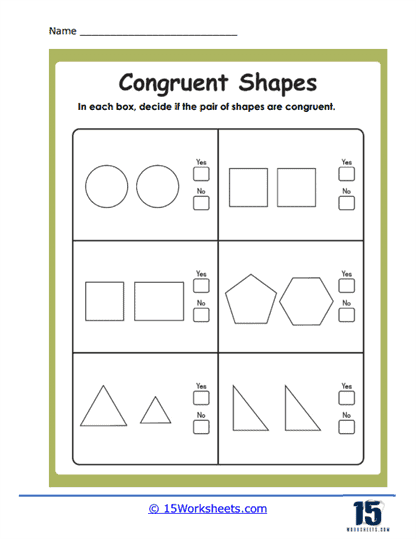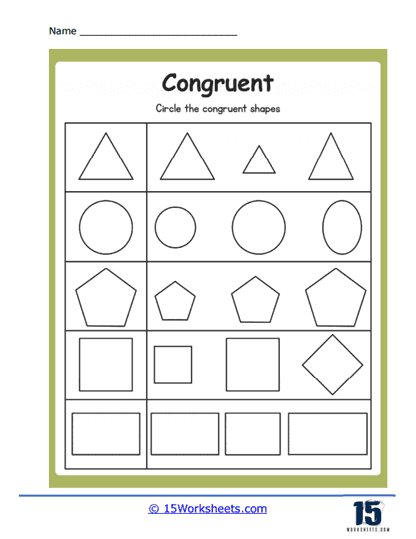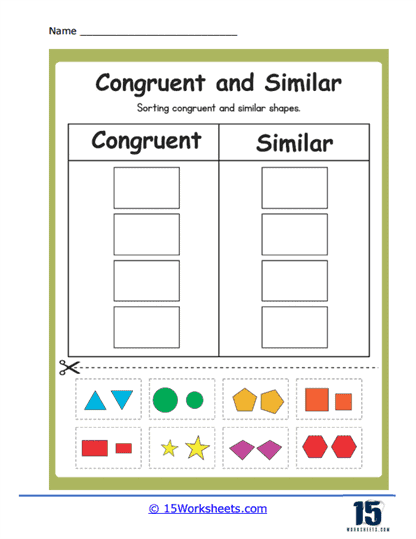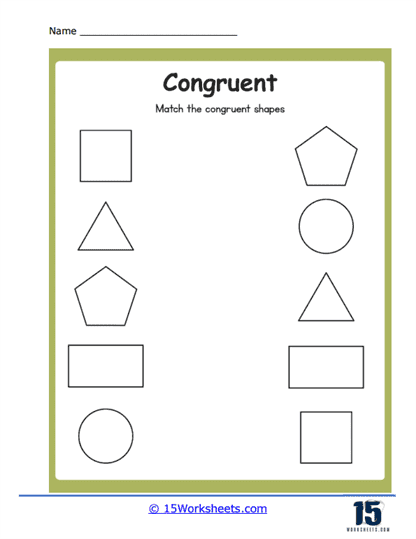Congruent and Similar Worksheets
About These 15 Worksheets
Congruent and similar shapes worksheets are an essential part of introductory geometry curriculum that help students grasp the concepts of congruence and similarity. These worksheets typically feature a variety of problems and exercises designed to enhance students’ understanding and application of these geometric principles.
Understanding Congruence in Geometry
In geometry, congruence refers to the property of figures or shapes that are identical in both shape and size. Two figures are considered congruent if one can be transformed into the other through a series of rigid motions, which include translations (sliding), rotations (turning), and reflections (flipping). These transformations do not alter the size or shape of the figure, meaning the corresponding sides and angles of the two figures remain equal. Congruence is denoted symbolically by the symbol “≅”. For example, if triangle ABC is congruent to triangle DEF, it is written as △ABC ≅ △DEF, indicating that the corresponding sides (AB = DE, BC = EF, and AC = DF) and angles (∠A = ∠D, ∠B = ∠E, and ∠C = ∠F) are equal.
Congruence is a fundamental concept in geometry because it allows for the comparison and classification of shapes based on their properties. This concept is widely used in various geometric proofs and theorems, such as proving the properties of triangles, quadrilaterals, and other polygons. It also has practical applications in fields such as engineering, architecture, and computer graphics, where precise measurements and identical shapes are crucial.
Understanding Similarity in Geometry
Similarity, on the other hand, refers to the property of figures that have the same shape but not necessarily the same size. Two figures are considered similar if their corresponding angles are equal and the lengths of their corresponding sides are proportional. Similarity is denoted by the symbol “~”. For example, if triangle ABC is similar to triangle DEF, it is written as △ABC ~ △DEF, indicating that the corresponding angles (∠A = ∠D, ∠B = ∠E, and ∠C = ∠F) are equal and the corresponding sides are in proportion (AB/DE = BC/EF = AC/DF).
Similarity is important in geometry because it helps in understanding the properties of shapes that are scaled versions of one another. This concept is extensively used in real-life applications, such as in map-making, where large areas are represented on a smaller scale, and in creating models or prototypes in engineering and design. Similarity also plays a crucial role in trigonometry and the study of similar triangles, which is foundational for solving many geometric problems and applications.
Types of Problems Working On Congruence
Identifying Congruent Figures – These problems present pairs or groups of geometric figures. Students are required to determine which figures are congruent by comparing their shapes and sizes.
Example – Compare triangles ABC and DEF to determine if they are congruent.
Matching Congruent Figures – Students are given a set of figures and must match each figure with its congruent counterpart.
Example: Match each shape on the left with its congruent shape on the right.
Proving Congruence – These exercises involve using congruence postulates and theorems such as Side-Side-Side (SSS), Side-Angle-Side (SAS), Angle-Side-Angle (ASA), and Angle-Angle-Side (AAS). Students must use these rules to prove that two figures are congruent.
Example: Prove that triangle ABC is congruent to triangle DEF using the ASA postulate.
Congruent Transformations – Problems that involve transformations such as translations, rotations, and reflections. Students need to apply these transformations to demonstrate that two figures are congruent.
Example: Reflect triangle ABC over the y-axis and prove it is congruent to triangle DEF.
Real-Life Applications – These problems apply the concept of congruence to real-life situations, such as architecture and design.
Example: Determine if two different-sized windows are congruent if they are scaled versions of each other.
Types of Problems in Similarity
Identifying Similar Figures – Students are given pairs of figures and must determine which ones are similar by comparing their shapes and the ratios of their corresponding sides.
Example – Determine if rectangle ABCD is similar to rectangle EFGH.
Matching Similar Figures – Similar to matching congruent figures, students match each figure with its similar counterpart.
Example: Match each triangle on the left with a similar triangle on the right.
Proving Similarity – These exercises involve using similarity postulates and theorems such as Angle-Angle (AA), Side-Angle-Side (SAS), and Side-Side-Side (SSS). Students must use these rules to prove that two figures are similar.
Example: Prove that triangle ABC is similar to triangle DEF using the AA postulate.
Scale Factors – Problems that require students to calculate the scale factor between two similar figures. This involves determining the ratio of corresponding side lengths.
Example: Calculate the scale factor of two similar triangles where one has sides of length 3, 4, and 5, and the other has sides of length 6, 8, and 10.
Transformations and Similarity – Problems that involve transformations such as dilations. Students need to apply these transformations to show that two figures are similar.
Example: Dilate triangle ABC by a scale factor of 2 and prove that the resulting triangle is similar to triangle DEF.
Word Problems – These problems apply the concept of similarity to real-world contexts, such as maps, models, and shadows.
Example: A model car is 1/10th the size of the actual car. If the actual car is 4 meters long, how long is the model car?
How Do These Worksheets Help Students?
Developing Analytical Skills
Working through congruent and similar worksheets helps students develop critical thinking and analytical skills essential for solving mathematical problems and beyond. By engaging with problems that require identifying and proving the properties of congruent and similar figures, students learn to observe patterns, make logical deductions, and construct coherent arguments. This process involves breaking down complex problems into manageable parts, fostering a methodical approach to problem-solving. Additionally, the skills honed in these exercises-such as attention to detail, systematic reasoning, and the ability to validate conclusions-are transferable to other academic subjects and everyday decision-making processes.
Understanding Geometric Principles
Congruent and similar worksheets reinforce fundamental geometric principles, providing students with a solid foundation in geometry. Through repetitive practice, students gain a comprehensive understanding of how different geometric shapes relate to one another. This includes recognizing that congruent figures are identical in shape and size, while similar figures maintain the same shape but differ in size. These exercises help students internalize the properties and relationships of geometric figures, which are crucial for understanding more advanced geometric concepts. Furthermore, this understanding extends to real-world contexts, such as how objects can be scaled while maintaining proportionality, enhancing students’ spatial reasoning and visualization skills.
Preparation for Advanced Studies
Mastering the concepts of congruence and similarity through these worksheets prepares students for more advanced topics in geometry and other areas of mathematics. These foundational skills are crucial for higher education in STEM fields, where complex geometric principles are often applied. For example, understanding congruence and similarity is essential for trigonometry, calculus, and physics, where precise measurements and relationships between shapes are critical. The logical reasoning and problem-solving abilities developed through these exercises provide a strong foundation for tackling advanced mathematical theories and applications, ensuring students are well-equipped for academic success in rigorous STEM programs.
Practical Applications
The ability to recognize and apply congruence and similarity is immensely useful in many practical scenarios. In design and architecture, these concepts are fundamental for creating structures that are both aesthetically pleasing and structurally sound. For instance, knowing how to scale models accurately ensures that buildings and products maintain their proportions and functionality when resized. In everyday life, understanding these geometric principles can aid in tasks such as resizing images, crafting, or even cooking, where proportions matter. Additionally, artists and designers use the concepts of congruence and similarity to create harmonious and balanced compositions, demonstrating the wide-ranging applications of these geometric skills.








